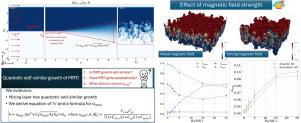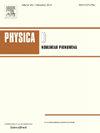非线性磁瑞利-泰勒不稳定性的自相似与增长——磁场强度的作用
IF 2.9
3区 数学
Q1 MATHEMATICS, APPLIED
引用次数: 0
摘要
在几个实验室和天体物理系统的背景下研究了磁瑞利-泰勒不稳定性(MRTI)的非线性状态。然而,几个基本方面仍不明朗。其中之一是不稳定性的自相似演化。研究假设非线性MRTI具有与流体动力(HD) RTI类似的自相似的二次增长。然而,自相似和二次增长都没有得到解析证明。此外,对控制非线性不稳定性增长的因素的明确理解仍然不清楚。众所周知,磁场在不稳定性的演变中起着至关重要的作用。然而,关于磁场如何影响不稳定性增长的系统研究尚缺乏。通过对均匀磁场的MRTI进行分析和数值研究,解决了这些问题。我们的研究表明,施加的磁场不符合HD自相似演化。然而,相对于其他非线性项,施加磁场的影响随时间(t)衰减为1/t,使得MRTI符合HD自相似性。因此,HD RTI自相似尺度在非线性动力学占主导地位的后期与MRTI相关。在能量守恒的基础上,导出了混合层高度h随时间的二次增长方程。这使我们深入了解了可能影响不稳定性非线性增长的各种因素。通过对不同磁场强度下MRTI的研究,证明了磁场强度对MRTI非线性生长的影响。因此,本研究从解析和数值上证明了磁场对MRTI演化的作用。本文章由计算机程序翻译,如有差异,请以英文原文为准。

Self-similarity and growth of non-linear magnetic Rayleigh–Taylor instability — Role of the magnetic field strength
The non-linear regime of the magnetic Rayleigh–Taylor instability (MRTI) has been studied in the context of several laboratory and astrophysical systems. Yet, several fundamental aspects remain unclear. One of them is the self-similar evolution of the instability. Studies have assumed that non-linear MRTI has a self-similar, quadratic growth similar to hydrodynamic (HD) RTI. However, neither self-similarity nor quadratic growth has been proved analytically. Furthermore, an explicit understanding of the factors that control the growth of non-linear instability remains unclear. Magnetic fields are known to play a crucial role in the evolution of the instability. Yet, a systematic study discussing how the magnetic field influences the instability growth is missing. These issues were addressed by performing an analytical and numerical study of the MRTI with a uniform magnetic field. Our study reveals that the imposed magnetic field does not conform to the HD self-similar evolution. However, the influence of the imposed magnetic field decays with time () as relative to the other non-linear terms, making the MRTI conform to the HD self-similarity. Thus, the HD RTI self-similar scaling becomes relevant to MRTI at late times, when nonlinear dynamics dominate. Based on energy conservation, an equation for the mixing layer height () is derived, which demonstrates the quadratic growth of in time. This gave insight into various factors that could influence the non-linear growth of the instability. By studying MRTI at different magnetic field strengths, we demonstrate the role of magnetic field strength on the nonlinear growth of MRTI. Thus, the current study analytically and numerically proves the role of magnetic fields on the evolution of MRTI.
求助全文
通过发布文献求助,成功后即可免费获取论文全文。
去求助
来源期刊

Physica D: Nonlinear Phenomena
物理-物理:数学物理
CiteScore
7.30
自引率
7.50%
发文量
213
审稿时长
65 days
期刊介绍:
Physica D (Nonlinear Phenomena) publishes research and review articles reporting on experimental and theoretical works, techniques and ideas that advance the understanding of nonlinear phenomena. Topics encompass wave motion in physical, chemical and biological systems; physical or biological phenomena governed by nonlinear field equations, including hydrodynamics and turbulence; pattern formation and cooperative phenomena; instability, bifurcations, chaos, and space-time disorder; integrable/Hamiltonian systems; asymptotic analysis and, more generally, mathematical methods for nonlinear systems.
 求助内容:
求助内容: 应助结果提醒方式:
应助结果提醒方式:


